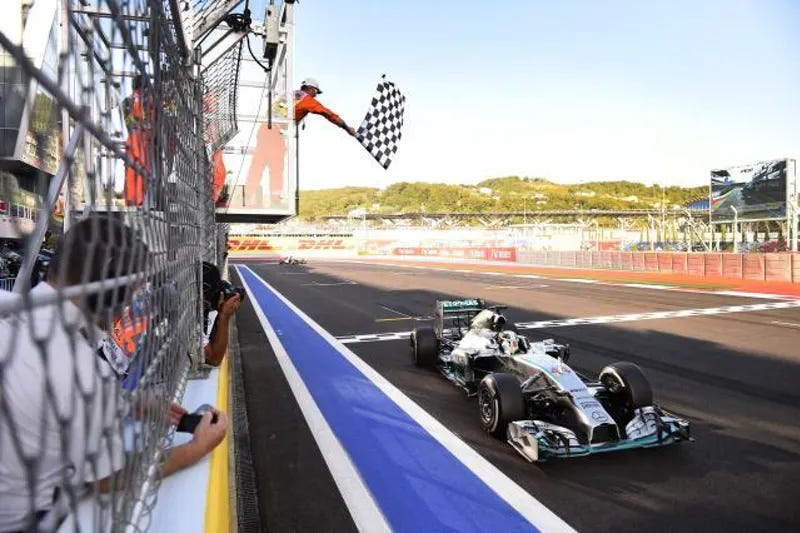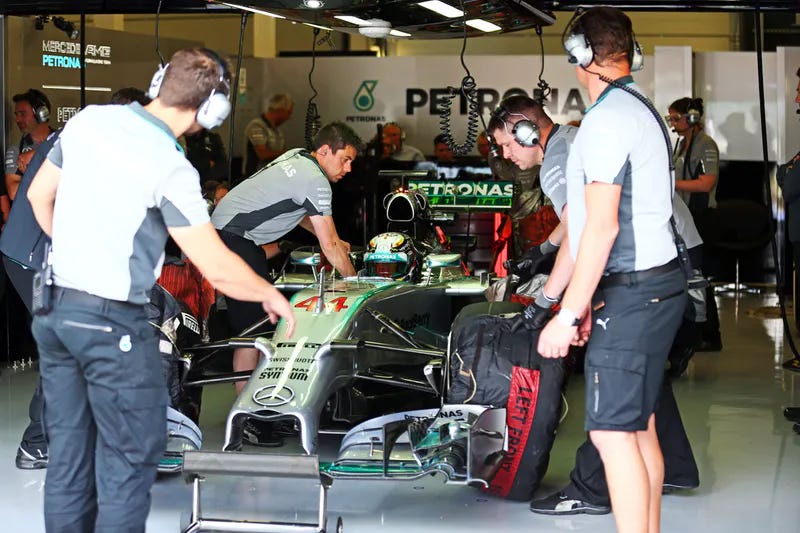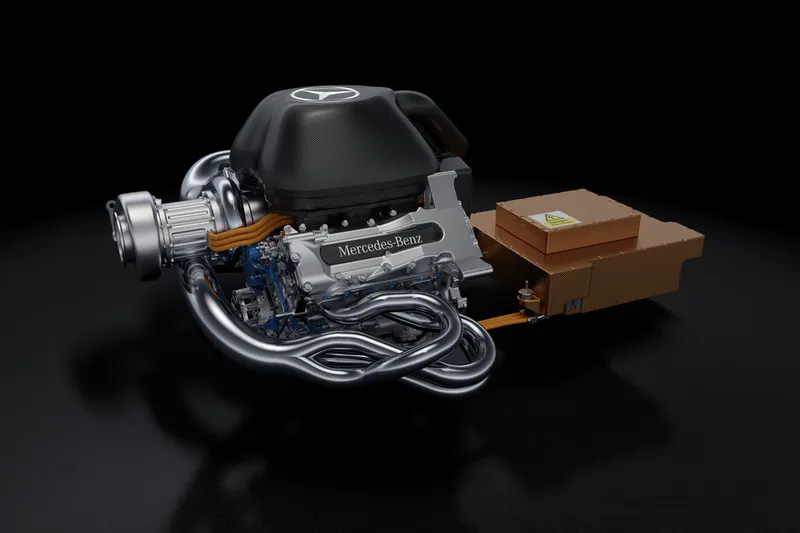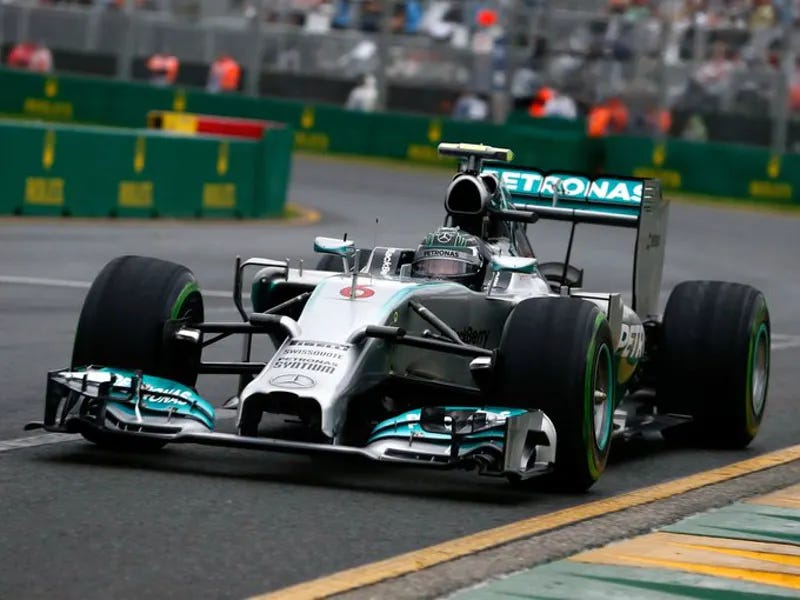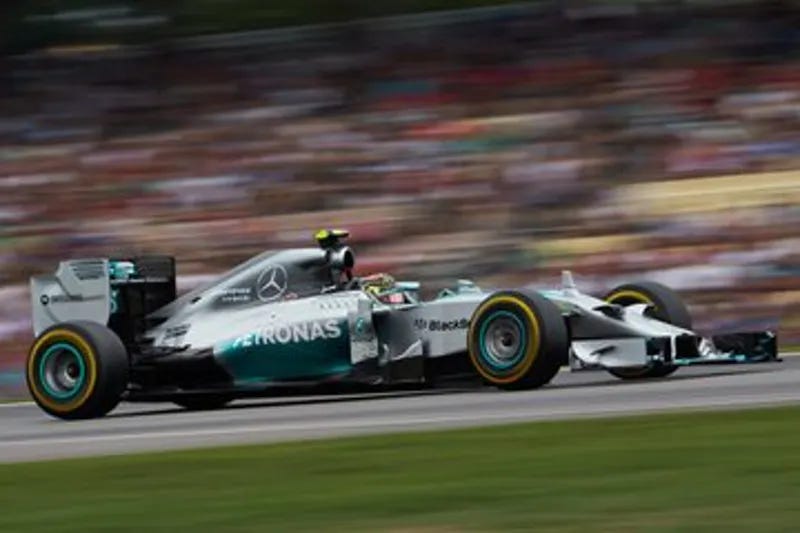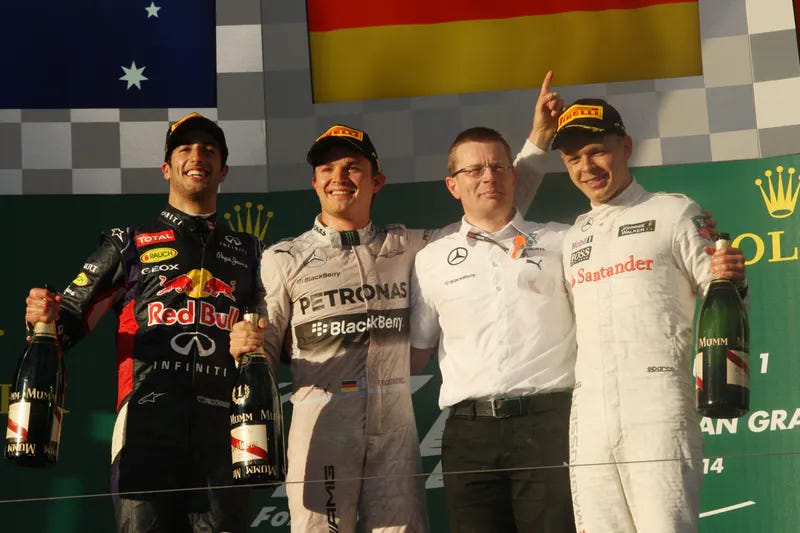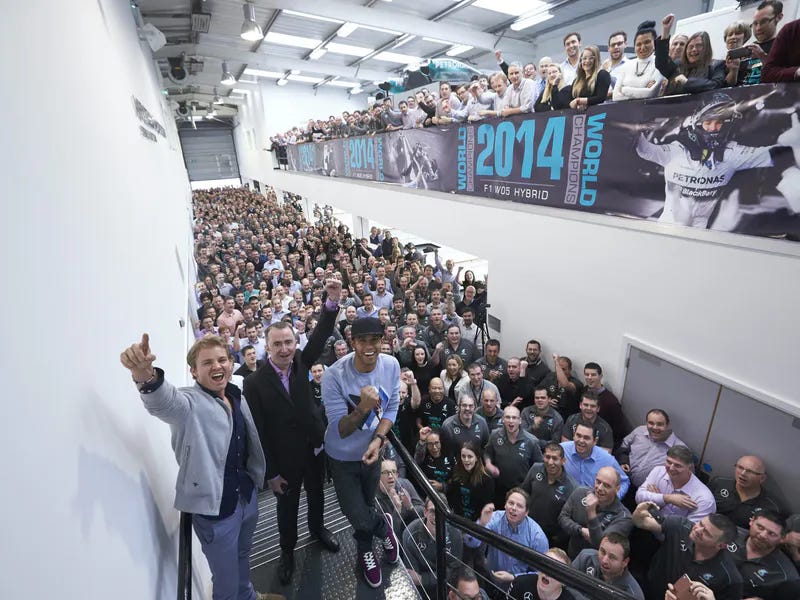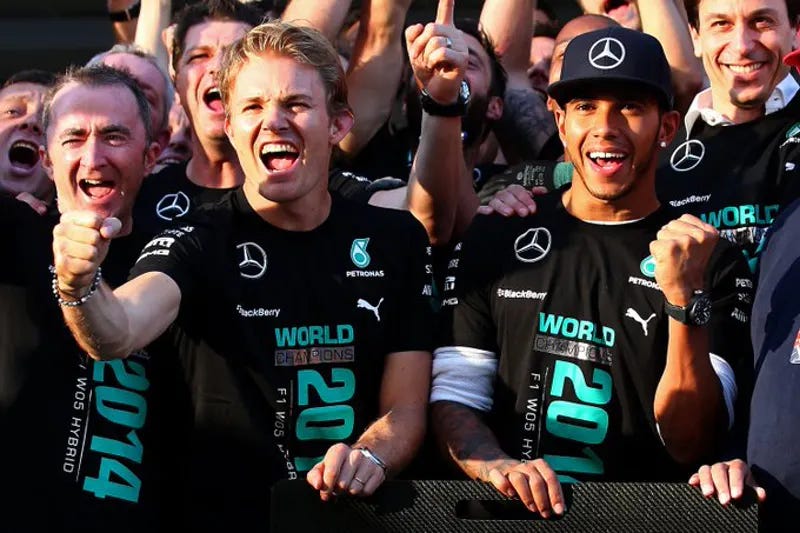The Untold Story of the Best-Ugly Formula One Car - Ever
And yes, there were some that looked at lot worse. At least this one went fast.
It's fair to say the 2014 regulation changes were a shock. We went from loud, big and fast to quieter, smaller and slower - but that's not to say it was worse. 2014 played host to a titanic title battle that went right down to the wire, and one that would turn childhood friends Lewis Hamilton and Nico Rosberg into bitter rivals. But we're not here to talk about that, we're here to talk about the car that played protagonist during the season; the WO5.
2014 : The Overlooked F1 Classic
This is the remarkable story of F1's best-ugly car.
With 16 wins, 18 pole positions and two maiden - utterly dominant - world championships, you'd think Mercedes had it easy. But that would mean you were unaware of the crisis they faced just a few months before the start of the season.
Had Mercedes not responded to their early issues, the inaugural year of the rule changes may have looked very different - as well as the whole of the hybrid era.
Andy Cowell recalls, 'The big 'oh, Crikey’ moment, – and I’m coming up with a polite phrase there – was the week before the British Grand Prix in 2013,” he said when speaking to The Race.
“We use a quality gate process to track our projects. And every single time we have a quality gate, they’re red because we’re always trying to do more than possible. That’s what you do in motorsport, and you just about get it right the evening before.
“But this particular quality gate we were all sat there going, ‘This is the brightest red quality gate we’ve ever had’. We’ve now signed up Williams to join us for 2014, because we suspect that McLaren will be departing in 2015. So, we’ve got four teams expecting the power unit. The investment that had gone into the capability of Brackley was manifesting itself with a good season in 2013, winning races and taking the fight to Red Bull. And we couldn’t do a power curve. We’ve got all sorts of life support systems making the power unit work. "
Long story short, they thought it was going to be a disaster.
“We’d got this vision of eight cars in Melbourne wanting this power unit, trying to work out how many sets of hardware we actually needed to take to not completely embarrass ourselves. And then realising we need to start making it in about two months time.
“That was one of those gut-wrenching quality gates, where it was like ‘holy shit’. There’s eight cars, there’s a new set of regulations. And we’re in that creek without a paddle.”
At a company meeting on the Friday of the 2013 British GP, Mercedes admitted internally it was “in trouble”. Cowell recalls that the climax where it would be decided if Mercedes was going to fully back the 2014 project, or leave it on the backburner.
“Just imagine eight Mercedes/Brixworth-powered cars parked on the side of the track in Melbourne,” Cowell remembers saying. “That feels awful, doesn’t it?
“We’ve got an opportunity to shine. Big regulation changes don’t come along that often in the powertrain world. So come on, let’s grab hold of this opportunity and do something amazing.”
They all agreed. Mercedes stopped its non-essential activities and switched their focus from ‘winning the championship’ to ‘simply being ready for Australia’. Staff were doing an extra 10 hours per week.
"I think that one point is a point that the majority of people that were in the business at that time would recognise as a key point in the journey.” said Cowell, and he was right.
Overcoming setbacks is an underlying theme of Mercedes' era - much like their very first one before the British Grand Prix of 2013. The extent of its preparations was such that Mercedes made a single-cylinder prototype when F1 was planning for its turbo era to come in the form of inline-four engines.
"We had a single-cylinder running early on, which we had to adapt because we didn’t get all the parameters exactly as the regulations came out.
“We did a four-cylinder engine that we’d got head castings for and a crankcase ready for, which we threw in the skip!
“When it changed from the inline-four to the V6… yeah, we went home, we were grumpy, we had a glass of wine. But we dusted ourselves down and we came back the very next day, and we said ‘We’re going to have a V6 running before Christmas’. And we did have a V6 mule engine running before Christmas.
“So, we reacted with action.”
And this is what makes Mercedes so incredibly great. They take the obstacle, study it, work out how to beat it and then how to turn it into an advantage.
Their grasp of the KERS system meant they were in good shape as the new hybrid engine cited many similar concepts and technology. Mercedes already possessed battery, inverter and electric machine knowledge, and this gave their operations the confidence to commit to its own turbocharger design. Cowell said it meant “99% of the key ingredients were in our hands”.
“We did an additional V6 iteration compared with everybody else.”
It meant the quality and quantity of work Mercedes could get through trumped that of its rivals. The project was ambitious, from splitting the turbo and compressor arrangement – as requested by the chassis department – and making it work, to the approach HPP took through its development cycle.
Mercedes’ chief designer John Owen told The Race that not only was Cowell “very brave to indulge in the packaging” of the turbo-hybrid engine, he also had an ingenious but labour-intensive idea for the process.
“What he did is design three engines, effectively,” says Owen. “I think it weighed 250 kilos from memory, the first one. And it was an engine that was almost unbreakable. That was just there to understand performance development.
“He then made another engine that was very fragile, which was going to be the reliability engine, where they didn’t do much performance work.
“And then the third engine was kind of a marriage between the two of them, which is the one we took racing.
“Hats off to Brixworth for a very clever strategy there, I think they found a really, really good way of doing it. We heard other teams sort of tried to build their power unit for both performance and reliability and suffered the problems of lots of time spent with the engine broken and not being able to develop it.
“That was a really good call that they made. That’s why we were good on that side.” You might ask why the other teams didn't do so too, and the answer is simple: Mercedes started earlier and this gave them the time they needed to systematically work through the rules, and do so better than anyone else.
So the next stage of validation was to run the engine in the factory as if it was in a car, using a wireless telemetry link to observe all the data while it was run on the transient dyno. That taught Mercedes a lot about the installation and how temperatures would shift, exposing a lot of issues
Time and time again Mercedes would encounter a reliability problem and have to restart these learning loops, while also not getting the full learning out of each variant before committing to the next – because of the time pressures.
A couple of months later, in Bahrain testing, Mercedes struck gold again: “It was the first or second day. At lunchtime we literally wound in a performance update, which was one of the biggest performance updates I’ve ever seen.”
Advancements in power and reliability didn’t mean Mercedes turned up to pre-season testing where it wanted to be, let alone Melbourne. At Jerez, Mercedes rolled its cars out on time but its customer McLaren didn’t because a wiring loom had a coupe of wires the wrong way around. Even Mercedes wasn’t immune to electrical glitches and engine failures.
Ferrari also caught Mercedes’ eye, clocking a decent number of laps and also doing pitstops and live pullaways. Mercedes couldn’t; it hadn’t done the calibration work. So Ferrari was looking half-decent, if a little down on power.
As testing continued though, Mercedes edged ahead. The mileage increased, the lap times dropped. It was becoming clear that the Mercedes engine was the benchmark but it was also crucially lodged in a great chassis. Then in Bahrain, the best engine got even better. By the time testing finished Mercedes-powered cars had topped 11 of the 12 test days and were leagues clear in the mileage stakes. But the team still wasn’t ready.
“Pretty much every system was not tested to the degree that we’d like. I think all of that added up does make it the most uncertain start of a season. Which is why every race was a new experience to be honest.”
And the engine itself was still a colossal unknown. Cowell recalls the concern heading to Melbourne being: “Crikey how many more of those young failures are we going to experience for the first time on the other side of the planet from where the factory is? We’re not going to be able to work some magic overnight here, we’re just gonna have to load another one in.
“And are we going to get to the embarrassing point where there isn’t another one to load in the car, and the car’s in the garage because we’ve let the side down because everything’s blown up?"
Mercedes’ reliability concerns were made a harsh reality when Hamilton’s season opener was ruined almost instantly because of a coil drop tube problem. But Nico Rosberg won at a canter and the two would go on to dominate the season, with Hamilton prevailing in the title battle, and Mercedes crushed its opposition in the constructors’ championship.
Mercedes reaped the rewards of its intense, flawed, clever, frustrated preparations, and the trials and tribulations that took Mercedes to the brink of questioning if it was possible – then deciding emphatically that it was.
How did they do it? It's a mixture of many different factors, from realising early on everyone was going to be in trouble, to pouring all their resources into this problematic area, gambling - if it was even that - on the correct way to go about the configuration and their perseverant and resilient attitude to the work. After all, Mercedes' ethos of a positive work environment is what keeps them from imploding.
Everybody remembers the first Jerez test in 2014 – cars not firing up, cars not making it out of the pitlane, cars being loaded onto flat-bed trucks and returned to the garage. Mercedes’ motivation the previous summer at Silverstone was the grim prospect of suffering all of that – but they worried when it counted. And they fixed it before it counted. Cowell suspects the teams all went through the same thing, but what kept Mercedes ahead was their prior knowledge of it all.
“That made 2013 an exciting year, which to the outside world made 2014 look like a glorious success,” says Cowell.
“We were just the least bad.” Which is a great way to put it.
Everybody remembers the first Jerez test in 2014 – cars not firing up, cars not making it out of the pitlane, cars being loaded onto flat-bed trucks and returned to the garage. Mercedes’ motivation the previous summer at Silverstone was the grim prospect of suffering all of that – but they worried when it counted. And they fixed it before it counted. Cowell suspects the teams all went through the same thing, but what kept Mercedes ahead was their prior knowledge of it all.
“That made 2013 an exciting year, which to the outside world made 2014 look like a glorious success,” says Cowell.
“We were just the least bad.” Which is a great way to put it.
***
All quotes and pictures are sourced from The Race, @wearetherace and @C4F1
***




